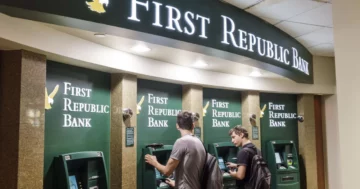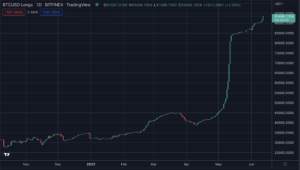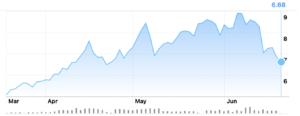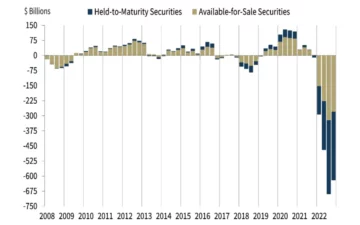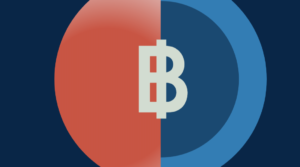USDc is back to being worth precisely one dollar after it fell to as low as 88 cent following revelations Circle held $3 billion in the Silicon Valley Bank (SVB).
The near collapse of SVB, which at some point held some $200 billion in deposits, sent ripples through crypto in a revelation of just how intertwined the old and new finance have become.
Even the very newest in defi which saw DAI dive to 90 cent, now back to $1.
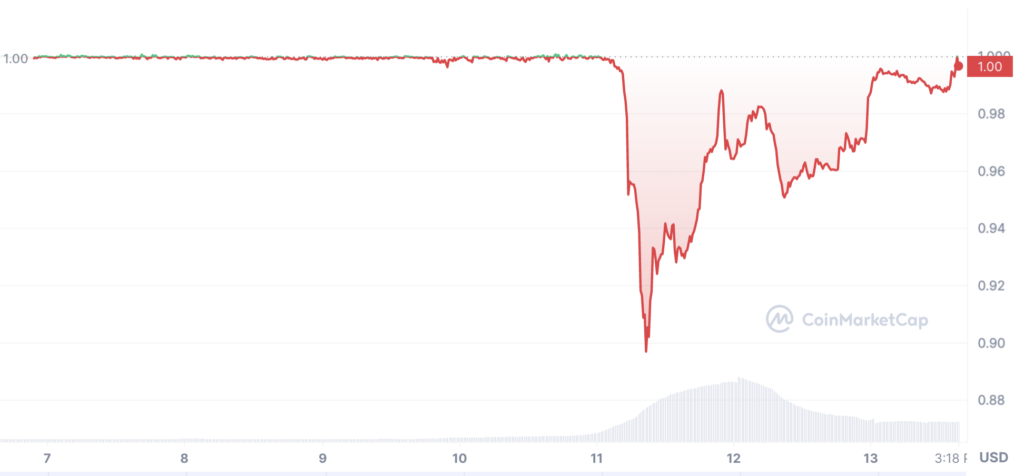
This so-called decentralized tokenized dollar happens to rely on USDc for some 80% of assets backing it.
Less a DAI therefore, it has kind of become a USDc, making it not surprising it tracked the de-peg almost to the dot.

But the saga is over. HSBC is buying the UK arm of SVB for £1, while in US the Biden administration has intervened in a ‘don’t call it a bailout manner.’
The Federal Reserve Banks have also established a new scheme to provide bonds and mortgage backed one year loans to banks so that they are not forced to sell assets to cover short term winds.
The solution is clearly to the satisfaction of the market as bitcoin’s dive to $20,000 has now been largely erased with it rising to $23,500 at the time of writing.
But the episode for some cryptos in particular may be decisive as the market may start wondering just what advantage does DAI really provide.
There is the Liquity USD (LUSD), which relies on only eth for its ‘dollar’ stability, and as you can expect this remained fairly stable.

There was some volatility, to the upside here, as the tokenized dollar was presumably absorbing some extra demand, but the small crypto with just a $250 million market cap has passed a test of sorts.
There’s also RAI, which is more complex in trying to maintain broader price stability rather than just against the dollar, and this too saw volatility to the upside first before bears tested the bull’s ‘exuberance.’
So it’s over. Spring is here, Trustnodes is back on new underlying tech that you might not easily notice, but this spectacular collapse of the bank of Silicon Valley gives credence to our caution until maybe September or October when the interest rate hikes hopefully finally clear.
China’s banks are in some trouble too and they have been for some time, keeping investors on their toes as Foreign Direct Investment plunges in Asia’s biggest economy.
There is a significant difference however between China’s banks and US’ SVB as the latter is far more sector specific, a tech sector that is seeing its first tightening in 15 years.
While for China the matter might be more systemic and wholistic as US’ decade long tech boom is more a three decades long whole country boom for China, which now has been busting.
For crypto specifically, the sharp differences between the old and the new in the socio-political arena could not be more starkly shown than by the collapse of FTX and SVB.
The former will see its CEO go to jail. The latter will probably be put down more to natural forces of complex finance that there isn’t much you can do about.
We can’t see SVB’s shenanigans on the blockchain either, if there were any, so ‘regulators’ won’t have too much of an incentive to look too much into anything.
This collapse also shows these regulations are not quite worth the paper they’re written in because they had no effect in 2008 and are having no effect in 2023.
The only real regulation is the market and the market participants who decide by the second who to punish and who to reward.
The hyaenas that were circling this space therefore have gotten some big egg, and their bear hug ‘protection’ will now fall on even more deaf ears because they need to sort out their own space first.
Which they can’t. Only crypto can. Here at least we can see with evidence just what exactly happened at FTX, and which part was ‘natural forces’ compared to the different sort of ‘natural’ forces.
All of which, in some ways, means crypto is back because fiat is not safe. The only optimal safety therefore is the diversification of assets that cryptos provide.
That visibly includes the US now, with jitters here potentially reverberating as monetary tightening continues with the donkeys seemingly blissfully unaware of just what going from 0% to 5% in interest rates in a year might mean.
- SEO Powered Content & PR Distribution. Get Amplified Today.
- Platoblockchain. Web3 Metaverse Intelligence. Knowledge Amplified. Access Here.
- Source: https://www.trustnodes.com/2023/03/13/usdc-and-dai-re-peg
- :is
- $3
- 000
- 15 years
- 2023
- a
- About
- administration
- ADvantage
- After
- against
- and
- ARE
- Arena
- ARM
- AS
- Asia’s
- Assets
- At
- back
- backed
- backing
- bailout
- Bank
- Banks
- BE
- Bear
- Bears
- because
- become
- before
- being
- between
- biden
- Biden Administration
- Big
- Biggest
- Billion
- blockchain
- Bonds
- boom
- broader
- Buying
- by
- call
- CAN
- cap
- ceo
- China
- Chinas
- Circle
- clear
- clearly
- Collapse
- compared
- complex
- continues
- could
- country
- cover
- crypto
- cryptos
- DAI
- decade
- decades
- decentralized
- decide
- decisive
- DeFi
- Demand
- deposits
- difference
- differences
- different
- direct
- diversification
- Dollar
- DOT
- down
- during
- easily
- economy
- effect
- either
- established
- ETH
- Even
- evidence
- exactly
- expect
- extra
- fairly
- Fall
- far
- Federal
- federal reserve
- Fiat
- Finally
- finance
- First
- following
- For
- Forces
- foreign
- Former
- from
- FTX
- gives
- Go
- going
- happened
- happens
- Have
- having
- Held
- here
- Hikes
- Hopefully
- How
- However
- HSBC
- HTTPS
- in
- Incentive
- includes
- interest
- INTEREST RATE
- INTEREST RATE HIKES
- Interest Rates
- investment
- Investors
- IT
- ITS
- jail
- keeping
- Kind
- largely
- Loans
- Long
- Look
- Low
- maintain
- Making
- manner
- March
- Market
- Market Cap
- Matter
- max-width
- means
- might
- million
- Monetary
- monetary tightening
- more
- Mortgage
- Natural
- Near
- Need
- New
- Newest
- october
- of
- Old
- on
- ONE
- optimal
- own
- Paper
- part
- participants
- particular
- passed
- plato
- Plato Data Intelligence
- PlatoData
- plunges
- Point
- potentially
- precisely
- price
- probably
- provide
- put
- Rate
- rate hikes
- Rates
- rather
- real
- Regulation
- regulations
- rely
- remained
- Reserve
- Reward
- ripples
- rising
- safe
- Safety
- saga
- satisfaction
- scheme
- Second
- sector
- seeing
- sell
- September
- sharp
- Short
- shown
- Shows
- significant
- Silicon
- Silicon Valley
- silicon valley bank
- small
- So
- solution
- some
- Space
- specific
- specifically
- spectacular
- spring
- Stability
- stable
- start
- surprising
- systemic
- tech
- test
- that
- The
- the UK
- their
- therefore
- These
- three
- Through
- tightening
- time
- to
- tokenized
- too
- Trustnodes
- Uk
- underlying
- Upside
- us
- USD
- USDC
- Valley
- Volatility
- ways
- What
- which
- while
- WHO
- will
- winds
- with
- wondering
- worth
- writing
- written
- year
- years
- zephyrnet



